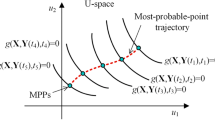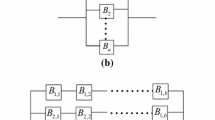Abstract
Time-variant reliability analysis can effectively estimate the safe state of structures under dynamic uncertainties during their lifecycle. However, one of its key challenging issues is computational efficiency. To improve the efficiency, this paper develops an approximation of the first-crossing probability density function (PDF) method, termed AFC-PDFM, based on the first-crossing theory. The response surface of the first-crossing time point (FCTP) about input variables is first estimated by using the moving least squares method (MLSM) and uniform design. Furthermore, an iterative algorithm is developed to compute the origin moments of the FCTP based on the MLSM response surface. Finally, the PDF of the FCTP is obtained by combining the origin moments and the maximum entropy method to avoid direct calculations of the first-crossing rate, which is often intractable, and then the time-variant reliability is estimated. Three examples are implemented to testify and validate the effectiveness of the proposed method and potential applications to engineering problems.












Similar content being viewed by others
References
Andrieu-Renaud C, Sudret B, Lemaire M (2004) The PHI2 method: a way to compute time-variant reliability. Reliab Eng Syst Saf 84:75–86
Chen J-B, Li J (2007) The extreme value distribution and dynamic reliability analysis of nonlinear structures with uncertain parameters. Struct Saf 29:77–93
Ching J, Au S-K, Beck JL (2005) Reliability estimation for dynamical systems subject to stochastic excitation using subset simulation with splitting. Comput Methods Appl Mech Eng 194:1557–1579
Dai H, Xue G, Wang W (2014) An adaptive wavelet frame neural network method for efficient reliability analysis. Comput Aided Civil Inf Eng 29:801–814
Du W, Luo Y, Wang Y (2019) A time-variant performance measure approach for dynamic reliability based design optimization. Appl Math Model 76:71–86
Engelund S, Rackwitz R, Lange C (1995) Approximations of first-passage times for differentiable processes based on higher-order threshold crossings. Probabilist Eng Mech 10:53–60
Fang K-T, Lin DK, Winker P, Zhang Y (2000) Uniform design: theory and application. Technometrics. 42:237–248
He J, Gao S, Gong J (2014) A sparse grid stochastic collocation method for structural reliability analysis. Struct Saf 51:29–34
Hu Z, Du X (2013a) A sampling approach to extreme value distribution for time-dependent reliability analysis. J Mech Des 135:071003
Hu Z, Du X (2013b) Time-dependent reliability analysis with joint upcrossing rates. Struct Multidiscip Optim 48:893–907
Hu Z, Du X (2015) Mixed efficient global optimization for time-dependent reliability analysis. J Mech Des 137:051401
Imani M, Braga-Neto UM (2017) Optimal finite-horizon sensor selection for Boolean Kalman filter. 2017 51st Asilomar Conference on Signals, Systems, and Computers: IEEE p. 1481–1485
Imani M, Braga-Neto UM (2018) Control of gene regulatory networks using Bayesian inverse reinforcement learning. IEEE/ACM transactions on computational biology and bioinformatics 16:1250–1261
Imani M, Ghoreishi SF. Bayesian optimization objective-based experimental design. Proceedings of the 2020 American Control Conference (ACC 2020), IEEE2020
Jiang C, Wei X, Huang Z, Liu J (2017) An outcrossing rate model and its efficient calculation for time-dependent system reliability analysis. J Mech Des 139:041402
Jiang C, Wei X, Wu B, Huang Z (2018) An improved TRPD method for time-variant reliability analysis. Struct Multidiscip Optim 58:1935–1946
Jiang C, Wang D, Qiu H, Gao L, Chen L, Yang Z (2019) An active failure-pursuing Kriging modeling method for time-dependent reliability analysis. Mech Syst Signal Process 129:112–129
Jiang C, Qiu H, Gao L, Wang D, Yang Z, Chen L (2020) Real-time estimation error-guided active learning Kriging method for time-dependent reliability analysis. Appl Math Model 77:82–98
Li G, Zhang K (2011) A combined reliability analysis approach with dimension reduction method and maximum entropy method. Struct Multidiscip Optim 43:121–134
Li H-S, Wang T, Yuan J-Y, Zhang H (2019) A sampling-based method for high-dimensional time-variant reliability analysis. Mech Syst Signal Process 126:505–520
Lorén S, Svensson T (2012) Second moment reliability evaluation vs. Monte Carlo simulations for weld fatigue strength. Qual Reliab Eng Int 28:887–896
Lv Q, Xiao Z-P, Ji J, Zheng J, Shang Y-Q (2017) Moving least squares method for reliability assessment of rock tunnel excavation considering ground-support interaction. Comput Geotech 84:88–100
Nobile F, Tempone R, Webster CG (2008) A sparse grid stochastic collocation method for partial differential equations with random input data. SIAM J Numer Anal 46:2309–2345
Pan Q, Dias D (2017) Sliced inverse regression-based sparse polynomial chaos expansions for reliability analysis in high dimensions. Reliab Eng Syst Saf 167:484–493
Papaioannou I, Betz W, Zwirglmaier K, Straub D (2015) MCMC algorithms for subset simulation. Probabilist Eng Mech 41:89–103
Ping M, Han X, Jiang C, Xiao X (2019) A time-variant extreme-value event evolution method for time-variant reliability analysis. Mech Syst Signal Process 130:333–348
Rice SO (1944) Mathematical analysis of random noise. Bell Syst Tech J 23:282–332
Rocco CM, Moreno JA (2002) Fast Monte Carlo reliability evaluation using support vector machine. Reliab Eng Syst Saf 76:237–243
Rosenblatt M (1952) Remarks on a multivariate transformation. Ann Math Stat 23:470–472
Shi Y, Lu Z, Cheng K, Zhou Y (2017a) Temporal and spatial multi-parameter dynamic reliability and global reliability sensitivity analysis based on the extreme value moments. Struct Multidiscip Optim 56:117–129
Shi Y, Lu Z, Zhang K, Wei Y (2017b) Reliability analysis for structures with multiple temporal and spatial parameters based on the effective first-crossing point. J Mech Des 139:121403
Sudret B (2008) Analytical derivation of the outcrossing rate in time-variant reliability problems. Struct Infrastruct Eng 4:353–362
Tayyab Z, Wang Z (2020) Time-dependent reliability prediction using transfer learning. Struct Multidiscip Optim. https://doi.org/10.1007/s00158-019-02475-5
Wang Z, Wang P (2012) A nested extreme response surface approach for time-dependent reliability-based design optimization. J Mech Des 134:121007
Wang Z, Wang P (2013) A new approach for reliability analysis with time-variant performance characteristics. Reliab Eng Syst Saf 115:70–81
Wang Z, Huang H-Z, Du X (2010) Optimal design accounting for reliability, maintenance, and warranty. J Mech Des 132:011007
Wang Z, Wang Z, Yu S, Cheng X (2019a) Time-dependent concurrent reliability-based design optimization integrating the time-variant B-distance index. J Mech Des 141(9):091403.1–091403.8
Wang L, Wang X, Li Y, Hu J (2019b) A non-probabilistic time-variant reliable control method for structural vibration suppression problems with interval uncertainties. Mech Syst Signal Process 115:301–322
Wang Z, Liu J, Yu S (2020) Time-variant reliability prediction for dynamic systems using partial information. Reliab Eng Syst Saf 195:106756
Xiao N-C, Zuo MJ, Zhou C (2018) A new adaptive sequential sampling method to construct surrogate models for efficient reliability analysis. Reliab Eng Syst Saf 169:330–338
Xu J, Kong F (2019) Adaptive scaled unscented transformation for highly efficient structural reliability analysis by maximum entropy method. Struct Saf 76:123–134
Yu S, Wang Z (2018) A novel time-variant reliability analysis method based on failure processes decomposition for dynamic uncertain structures. J Mech Des 140:051401
Yu S, Wang Z (2019) A general decoupling approach for time- and space-variant system reliability-based design optimization. Comput Methods Appl Mech Eng 357(2019):112608.1–112608.11260823
Yu S, Wang Z, Zhang K (2018a) Sequential time-dependent reliability analysis for the lower extremity exoskeleton under uncertainty. Reliab Eng Syst Saf 170:45–52
Yu S, Wang Z, Meng D (2018b) Time-variant reliability assessment for multiple failure modes and temporal parameters. Struct Multidiscip Optim 58:1705–1717
Yuan F (2018) Parameter estimation for bivariate Weibull distribution using generalized moment method for reliability evaluation. Qual Reliab Eng Int 34:631–640
Zhang D, Han X, Jiang C, Liu J, Li Q (2017) Time-dependent reliability analysis through response surface method. J Mech Des 139:041404
Zhao Y-G, Ono T (2001) Moment methods for structural reliability. Struct Saf 23:47–75
Replication of results
The results presented in this work are based on the flowchart in Fig. 2. To further understand the proposed method for time-variant reliability analysis and replicate the solutions presented in this paper, the MATLAB codes of the proposed ACF-PDFM for the numerical example are provided as the supplementary material.
Funding
This research was financially supported in part by the Dongguan University of Technology under research grant (KCYKYQD2017014), National Key R&D Program of China under the Contract No. 2017YFB1302301, and the National Natural Science Foundation of China under the Contract No. 11472075.
Author information
Authors and Affiliations
Corresponding authors
Ethics declarations
Conflict of interest
The authors declare that they have no conflict of interest.
Additional information
Responsible Editor: Byeng D Youn
Rights and permissions
About this article
Cite this article
Yu, S., Zhang, Y., Li, Y. et al. Time-variant reliability analysis via approximation of the first-crossing PDF. Struct Multidisc Optim 62, 2653–2667 (2020). https://doi.org/10.1007/s00158-020-02635-y
Received:
Revised:
Accepted:
Published:
Issue Date:
DOI: https://doi.org/10.1007/s00158-020-02635-y




